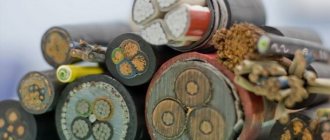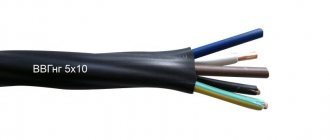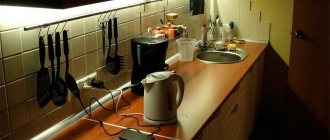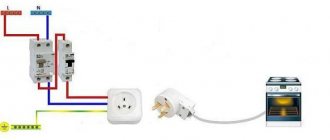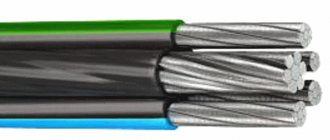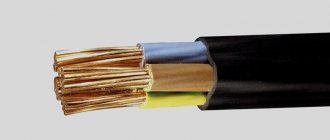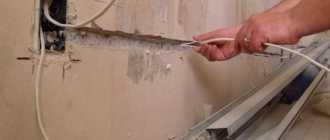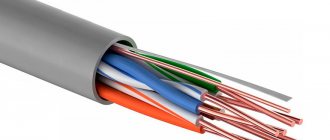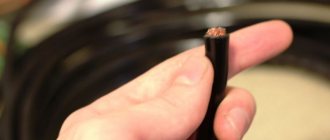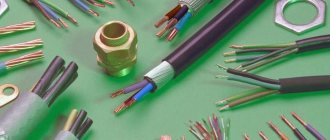How to choose the right SIP cable: cross-section table
Self-supporting insulated wire (SIP cable) was specially designed for transporting electricity.
Additionally, it can also perform a distribution function. At the same time, a power voltage indicator of 0.4-1 kV is fixed in the network. SIP wires are actively used to form construction highways at different distances from the power supply facility. Thanks to the design, it is easy to create special branches. They are necessary to supply electricity to residential and other types of buildings.
The appearance of the SIP is presented in the form of cores that are isolated from each other. Additionally, they are twisted. for production .
The composition must include a special cable as a zero phase.
Wire (cable) SIP-4 4x25 description
Wire SIP-4 4x25 is a high-quality four-core wire that is used for laying power lines. Its technical characteristics of use have made the wire very popular among a wide range of buyers. The main application of the SIP 4-4x25 cable is the creation of subscriber branches and inputs into residential and utility premises.
Self-supporting insulated wire can be used in a temperature range from minus 60 to plus 50 degrees. Installation is possible down to temperatures of minus 20 degrees. SIP is resistant to most types of external influences, including the influence of sunlight, precipitation and other atmospheric phenomena. Only the highest quality materials are used to make the wire, which allows us to achieve a high quality product.
Main cable brands
To increase the pressure inside the network, the cable is pre-painted black. It provides reliable protection against various degrees of ultraviolet radiation. The neutral core contains a steel core
. It is first wrapped around an aluminum wire.
Important! Light-stabilized polyethylene is used as an insulating material.
The choice of section is key
SIP. In this case, attention should be paid to the insulating material. The supporting part must also exactly meet all the requirements of the internal system.
That is why several types are actively used in construction. Each of them has a number of advantages and disadvantages:
View 1 and 1A.
The cables contain an aluminum core that is used to conduct current through the system. The top is insulated using a polyethylene plate.
It will not deteriorate even when exposed to ultraviolet rays. Depending on the chosen model, the neutral core can be bare or insulated. If the client chose brand “A”, the cable will be additionally protected by a layer of insulation. The structure will continue to function normally even when heated to 70 degrees.
View 2.
The design of this wire is similar to the previous one.
However, polyethylene made from cross-linked fragments is used as an insulating material .
In terms of power and length, this cable is ideal for creating lines that will operate under a voltage of 1000 V. The design will not be damaged even in the presence of a large amount of precipitation.
The cross-section of cables of this type allows their use in the formation of trunk lines that go to individual areas of electricity consumption. The design provides for the operation of cables in cold and temperate climates.
SIP-2 have a more advanced structure, so they allow temperatures to rise up to 90 degrees. However, during the installation process you should pay attention to the bending radius. This figure should not exceed ten outer diameters.
View 3.
This type of cable is also formed from a steel tip. However, it is additionally wrapped with aluminum on top. For this purpose, a specially created AlMgSi alloy is used. The cross-section of SIP-3 is increased due to cross-linked polyethylene, which does not suffer even when exposed to direct sunlight.
This wire option is ideal for the construction of overhead lines.
Electricity transmission on it is subsequently carried out at a voltage of 20 kV.
Climate conditions can be temperate, cold and even tropical. The system functions normally at a temperature of 70 degrees. However, manufacturers assure that the range can be from -20 to +90 degrees.
View 4.
The peculiarity of this brand is
its paired wires
. In this case, the structure does not include a zero phase. If the last letter of the marking is “H”, then only aluminum alloy is used in production. Otherwise, this element is not included in the general composition. The continuous current capacity is increased by insulation. It cannot be harmed by ultraviolet radiation. Thermoplastic PVC is completely immune to it.
View 5.
The structure of this model is similar. The difference can only be found in the design of cross-linked polyethylene.
Thanks to this, it was possible to increase the maximum permissible temperature by 30%.
This brand is suitable for creating power lines, because it can withstand voltages up to 2.5 kV.
The cores have the required cross-section for organizing the lighting process in various residential buildings.
They can also be used to form networks.
The wire will function normally in both moderate and cold climates.
Product marking
SIP cables are marked according to their type and cross-section, type of insulation, and technical properties. Manufacturers sometimes do not insulate the neutral core in some types of products: 1. SIP-1. The cable of this brand has 3 aluminum cores, for the insulation of which PET is used. This is the name of thermoplastic polyester - a synthetic film or fabric. The neutral core can be with or without insulation. If the letter “A” is present in the marking, the product is insulated. 2. SIP-2. This type of SIP cable has the same design as in the previous version with the difference that the neutral core is necessarily closed. This type of product is intended for installation on power lines whose voltage does not exceed 1000 V. Suitable for use in the northern regions of the country with a temperate climate. You can use a SIP cable for installation in summer cottages if the voltage does not exceed 380V.
3. SIP-3. This model differs significantly from previous product versions in its design - its core is made of steel and has an aluminum braid consisting of an alloy of silicon, magnesium, and aluminum. Single-core SIP wire is used when installing 20 kilovolt overhead lines. Manufacturers recommend using products of this type in areas with any climate, except sharply continental and arctic. According to the standards, this type of SIP wire can maintain its performance at temperatures from +90 to -20° C. 4. SIP-4. This type of product does not have a neutral wire. The design consists of several pairs of cores (two or four). If the marking contains the designation “H”, an alloy was used for their manufacture. If there is no letter designation, the cores are made of aluminum. Thermoplastic polyvinyl chloride is used for external insulation. 5. SIP-5. Products of this brand are similar in design to SIP-4 wires. The difference is the thermal insulation material - PET is used here. Thanks to this, the duration of exposure to permissible temperatures increases by 30%. SIP wires of this type are used for installation on 2.5 kilovolt power line supports. The installation of self-supporting insulated SIP-5 wires is allowed in areas with moderate and cold climates. What are the cross-sections of SIP cable? Phase conductors can have a cross-section with a diameter of 16 to 120 mm², and a zero-carrying conductor - from 25 to 95 mm².
Basic data table
You should choose a SIP cable based on its main characteristics. This is why the following table will be useful to buyers. It contains key indicators
, on which the duration of operation subsequently depends.
| View | Number of cores for carrying current | Maximum cross section | Working voltage class | Maximum heating temperature | Thermal insulation material |
| 1 | 1 ÷ 4 | 16 ÷ 120 | 0.4 ÷ 1 | 70 | Thermoplastic polyethylene |
| 2 | 1 ÷ 4 | 16 ÷ 120 | 0.4 ÷ 1 | 90 | Light-stabilizing polyethylene |
| 3 | 1 | 35 ÷ 240 | 10 ÷ 35 | 70 | Thermoplastic polyethylene |
| 4 | 2 – 4 | 16 ÷ 120 | 0.4 ÷ 1 | 90 | Light-stabilizing polyethylene |
| 5 | 2 – 4 | 16 ÷ 120 | 0.4 ÷ 1 | 90 | Light-stabilizing polyethylene |
Before choosing the right cable type, you need to carefully analyze the type of structure. power consumption plays an important role
. The resistivity directly depends on this value. You should buy SIP based on its main characteristics. They are always indicated in the instructions. You can also find out the specifics from a specialist in the field or a sales consultant.
Design and composition
Structurally, SIP consists of aluminum cores twisted together and protected by a durable layer of polyethylene. The conductors are light-stabilizing, therefore, when exposed to ultraviolet rays, their technical and operational characteristics do not change.
The shell of individual conductors in SIP is black. The cable includes a load-bearing element connected to the zero. The rest of the wires are wound around it.
In general, SIP consists of the following components:
- current-carrying conductors;
- steel wire core;
- high-strength polyethylene shell.
The SIP-3 power cable is made of aluminum conductors and a steel core with a round cross-section. The number of cores is formed in accordance with the standards of specifications individually for the selected brand. The design of SIP may imply the use of a self-supporting aluminum core; in SIP-3, SIP-4 and SIP-5 it is absent.
Important! The quality of the SIP can be judged by how the phase wire is twisted. It always moves clockwise relative to zero.
In the electric cable SIP-2, SIP-3 or SIP-5, the sheath is made of cross-linked XLPE, which increases light stabilization. In SIP-1 and SIP-4 it is made from thermoplastic polyethylene (LDPE).
Application benefits
The cross-section of the SIP wire allows it to withstand high current loads.
Thanks to this, it is possible to significantly extend the period of uninterrupted operation. Bare wires, compared to data, fail much more often. They can no longer fully cope with the electricity demands that large cities put forward. At the first stage of selection, the section should be calculated. It directly depends on the amount of load.
Important!
The wire cross-section was specially designed in such a way as to save on electricity transmission.
At the same time, the likelihood of its loss is minimized. Additional advantages include low cost of cable installation
. Such installation will cost several times less, especially if compared with standard wires.
Before selecting the necessary material, you should understand what types of cables there are and what their operating capacities depend on.
Today, the SIP option is used in several household and industrial applications.
industries. It will last much longer than the regular version. That is why the owner will be able to save significantly.
However, it is important to correctly calculate the cross section. In this case, the power consumption is enough to illuminate the selected object.
Thanks to careful insulation and a wide selection of cross-sections, it is possible to prevent short circuits during operation. This negative situation is also observed if the wires get tangled in branches
. When installing, it is important to use craftsmen with extensive experience in this field. It is best to check their qualifications first.
Additional savings can also be achieved due to the fact that there is no need to use insulating material. For installation, only special reference voltages should be used that can withstand the required load.
SIP cable is an innovative alternative to bare cable. It has gone through several stages of improvement, so it is actively being introduced into several areas of human life at once.
Source
SIP technical characteristics Technical characteristics of self-supporting SIP wire
Explanation of SIP marking:
- C - self-supporting;
- I - isolated;
- P - wire.
The letter at the end of the marking means:
- “A” - neutral core with insulation
- “H” - current-carrying conductors are made of aluminum alloy
- “T” - insulation resistant to elevated temperatures +90°C (short-term +120°C)
- “G” - sealed (moisture will not spread along the wire more than 3 meters from damage to the insulation)
In the marking of a SIP wire, a dash sign indicates the rated voltage for which the wire is intended. Sometimes two values can be indicated here separated by a slash. For example, 0.6/1. This means that the wire is designed for voltages of 660 or 1000V.
And the last thing in the marking is the technical condition according to which the wire is made. Usually this is a set of numbers after the abbreviation TU.
Cable marking, in addition to designating a specific group, also necessarily includes the wire cross-section, date of manufacture, batch number and additional information from the manufacturer.
Peculiarities
SIP is a self-supporting insulated wire, used for power supply in power networks. The SIP electric cable is used in a network with voltage: SIP-1, SIP-2, SIP-4 and SIP-5 are designed for a rated voltage of up to 1 kV, SIP-3 up to 35 kV.
Most SIP wires produced in Russia are color-coded in accordance with the PUE (Electrical Installation Rules) and the new GOST 50462-2009. The insulation of phase conductors and the supporting neutral conductor is made of thermoplastic polyethylene or silanol-cross-linked (light-stabilized) polyethylene, which can withstand temperatures of about 80-90°C for a long time
The technical characteristics of the SIP cable are regulated by GOST R 52373-2005 / GOST 31946-2012 / TU 16-705.500-2006, according to which self-supporting insulated wires include products for overhead lines with voltages up to 0.6/1 kV inclusive, and protected wires, products for the same lines, but with voltage up to 10 kV; from 10 to 20 kV; 20 kV and 35 kV. There are different types of SIP wire. Most often, SIP type cables are classified by cross-section: 4x16, 2x16, 4x50, 4x25, 4x35, etc. Also, the brand of wire is divided according to the type of core insulation and technical characteristics:
- SIPT-1, also known as SIP-1 - except for the zero core, all the rest are insulated with special polyethylene. SIP-1 is produced for 380 V networks. This is a four-wire cable made of aluminum or aluminum alloy, three cores are covered with light-resistant polyethylene, resistant to ultraviolet radiation, and the fourth without braid with a steel core acts as a carrier and neutral.
- SIPT-2 and SIPT-1A - all threads are isolated;
- SIP-2 - all cores (except for the zero wire) are insulated with cross-linked polyethylene;
- SIP-2A - all conductors, including neutral, are covered with a layer of cross-linked polyethylene;
- SIP-3 - a wire consisting of one conductive core, made of a dense alloy or steel-aluminum wire structure, the insulating layer is made of cross-linked light-stabilized polyethylene. SIP-3 is used for transmitting electrical energy with voltages up to 20 kV;
- SIP-4 - all four cores are insulated with thermoplastic polyethylene, but there is no separate load-bearing core. When laying and tensioning the line, all conductors carry the load, i.e. fastening is carried out immediately for all conductors;
- SIP-5 - does not have a separate load-bearing core, the rest are covered with a sheath of cross-linked (light-stabilized) polyethylene, the number of cores is two or more. They are used mainly in enterprises or for extending electrical networks in the city or between populated areas. It consists of insulated strands coated with polyethylene, where each strand is wrapped in a separate sheath. Types of wire SIP-4 and SIP-5 do not have a supporting zero core and can consist of two or more threads (most often 2 or 3).
How to determine the cross-section of a stranded wire by its diameter?
Single core wires.
Types of solid wires.
Electric wire is a cable product containing one or more twisted wires or one or more insulated cores, on top of which, depending on the installation and operating conditions, there may be a light non-metallic sheath, winding and (or) braid made of fibrous materials or wire, and not intended, usually for laying in the ground.
As a rule, copper or aluminum wire is used as a conductor. The core can consist of several wires (usually twisted) - multi-wire core.
Not to be confused with stranded wire, where each core is an independent wire.
The wire consists of the following elements:
1. A conductor that conducts electric current (copper or aluminum).
2. Insulating shell.
Single core solid wire.
Solid Stranded Wire
A cable is a structure of one or more conductors (cores) insulated from each other, or optical fibers enclosed in a sheath.
Wire classification:
1. winding wires:
copper wires (grades PEV, PEL, PETV-2, PET-155, LELO, LENK, etc.);
high resistance wires (constantan, manganin, nichrome);
2. installation wires (brands MGTF, MGTFE, etc.);
3. connecting wires (brands PVS, PRS, Ball Screw, etc.);
4. output wires (brands PVKV, RKGM, VPP, etc.);
5. wires for rolling stock (brands PPSV, PPSRN, PS, etc.);
6. automobile wires (brands PGVA, PGVAE, PVAM, etc.);
7. aviation wires (brands BPVL, BIF, BIN);
8. installation wires (grades APV, PV1, PV2, PV3, etc.);
9. communication wires (brands PVZh, PPZh, PKSV, etc.);
10. insulated wires for overhead lines (grades SIP-1, SIP-2, SIP-3, etc.);
11. bare wires (grades M, A, AC, etc.);
12. wires for geophysical work (grades GSP, GPMP, etc.);
13. heat-resistant wires (brands PVKV, PAL, PVKF);
14. thermoelectrode wires (grades SFK-KhK, PTV-KhK, PTP-KhK, etc.);
15. warm-up wires (brands PNSV, PNPZh, NO-1, etc.).
Parameters of single-core wires
The wires include the following parameters: cross-sectional area, operating voltage and frequency, core material, type of insulation, flexibility, heat resistance, operating temperature range, relative air humidity during operation, wire bending radius, wire color, etc.
Calculation of cable cross-section
The cross-section of the wire can be determined by the diameter of the core. In practice, the diameter of the core without insulation is most often measured with a caliper or micrometer. Knowing the diameter of the core, it is quite easy to determine the cross-section of the wire. To do this, you need to use the wire cross-section formula, which coincides with the usual school formula for calculating the circle area, which is given below.
Calculation example
The warehouse received a single-core single-wire wire PV-1 without markings with a core diameter of 3.57 mm. Let's determine the cross-section of the wire by diameter: Scr=3.14*3.57^2/4=10 mm2
The nearest standard section is 10mm2. Thus, the PV1 10 wire was delivered to the warehouse.
How to determine the cross-section of a stranded wire by its diameter?
If the wire is multi-wire, then you need to fluff it up and count the number of wires in the bundle. Determine the diameter of one wire, calculate its cross-sectional area s, then determine the cross-sectional area of the entire wire by adding up the areas of all the wires.
For example: the number of wires in a bundle is 37 pieces; diameter of each wire d = 0.3 mm. Let us determine the cross-sectional area of one wire. s = 0.785*d² = 0.785 *0.3*0.3 = 0.070 mm2 Sectional area of the entire stranded wire S = 37*s = 37*0.070 = 2.59 mm2
Application of SIP wire:
SIP-1 For mains of overhead power lines (OHT) and linear branches from OHL for rated voltage up to 0.6/1 kV inclusive, with a nominal frequency of 50 Hz in an air atmosphere of types I and II according to GOST 15150.
SIP-2 For mains of overhead power lines (OHT) and linear branches from OHL for rated voltage up to 0.6/1 kV inclusive with a rated frequency of 50 Hz in an air atmosphere of types II and III according to GOST 15150, including on the coasts of seas, salty lakes, industrial areas and areas of saline sands.
SIP-3 - For overhead power lines with a rated voltage of 20 kV (for networks with voltages of 10, 15, 20 kV) and 35 kV (for networks with 35 kV) with a nominal frequency of 50 Hz in air atmosphere II and III according to GOST 15150, including including on the coasts of seas, salt lakes, in industrial areas and areas of saline sands.
SIP-4 Designed for branches from overhead lines to the input and for laying along the walls of buildings and engineering structures for rated voltage up to 0.6/1 kV inclusive, with a nominal frequency of 50 Hz in air atmosphere II and III according to GOST 15150.
Mechanical characteristics of SIP wire
| Brand and rated voltage of the wire | Nominal outer diameter, mm | Estimated outer diameter of the wire, mm" | Estimated weight of 1 km of wire, kg |
| SIP-1-0.6/1 | 1×16+1×25 | 15 | 135 |
| 3×16+1×25 | 22 | 270 | |
| 3×25+1x35 | 26 | 390 | |
| 3×35+1×50 | 30 | 530 | |
| 3×50+1×50 | 32 | 685 | |
| 3×50+1×70 | 35 | 740 | |
| 3×70+1×70 | 37 | 930 | |
| 3×70+1×95 | 41 | 990 | |
| 3×95+1×70 | 41 | 1190 | |
| 3×95+1×95 | 43 | 1255 | |
| 3×120+1×95 | 46 | 1480 | |
| 3x150+1x95 | 48 | 1715 | |
| 3×185+1×95 | 52 | 2330 | |
| 3×240+1×95 | 56 | 2895 | |
| SIP-2-0.6/1 | 3×16+1×25 | 24 | 308 |
| 3×16+1×54.6 | 28 | 427 | |
| 3×25+1×35 | 27 | 424 | |
| 3x25+1x54.6 | 30 | 512 | |
| 3×35+1×50 | 31 | 571 | |
| 3×35+1×54.6 | 32 | 606 | |
| 3×50+1×50 | 34 | 727 | |
| 3×50+1×54.6 | 35 | 762 | |
| 3×50+1×70 | 36 | 798 | |
| 3×70+1×54.6 | 39 | 973 | |
| 3×70+1×70 | 40 | 1010 | |
| 3×70+1×95 | 41 | 1087 | |
| 3×95+1×70 | 43 | 1240 | |
| 3×95+1×95 | 45 | 1319 | |
| 3×120+1×95 | 48 | 1553 | |
| 3×150+1×95 | 50 | 1787 | |
| 3×185+1×95 | 55 | 2403 | |
| 3×240+1×95 | 60 | 2968 | |
| SIP-3 -20 | 1×35 | 12 | 165 |
| 1×50 | 13 | 215 | |
| 1×70 | 15 | 282 | |
| 1×95 | 16 | 364 | |
| 1×120 | 18 | 445 | |
| 1×150 | 19 | 540 | |
| 1×185 | 21 | 722 | |
| 1×240 | 24 | 950 | |
| SIP-3-35 | 1×35 | 14 | 209 |
| 1×50 | 16 | 263 | |
| 1×70 | 17 | 334 | |
| 1×95 | 19 | 421 | |
| 1×120 | 20 | 518 | |
| 1×150 | 22 | 618 | |
| 1×185 | 24 | 808 | |
| 1×240 | 26 | 1045 | |
| SIP -4 0.6/1 kV | 2x16 | 15 | 139 |
| 4x16 | 18 | 278 | |
| 2x25 | 17 | 196 | |
| 4x25 | 21 | 392 |
